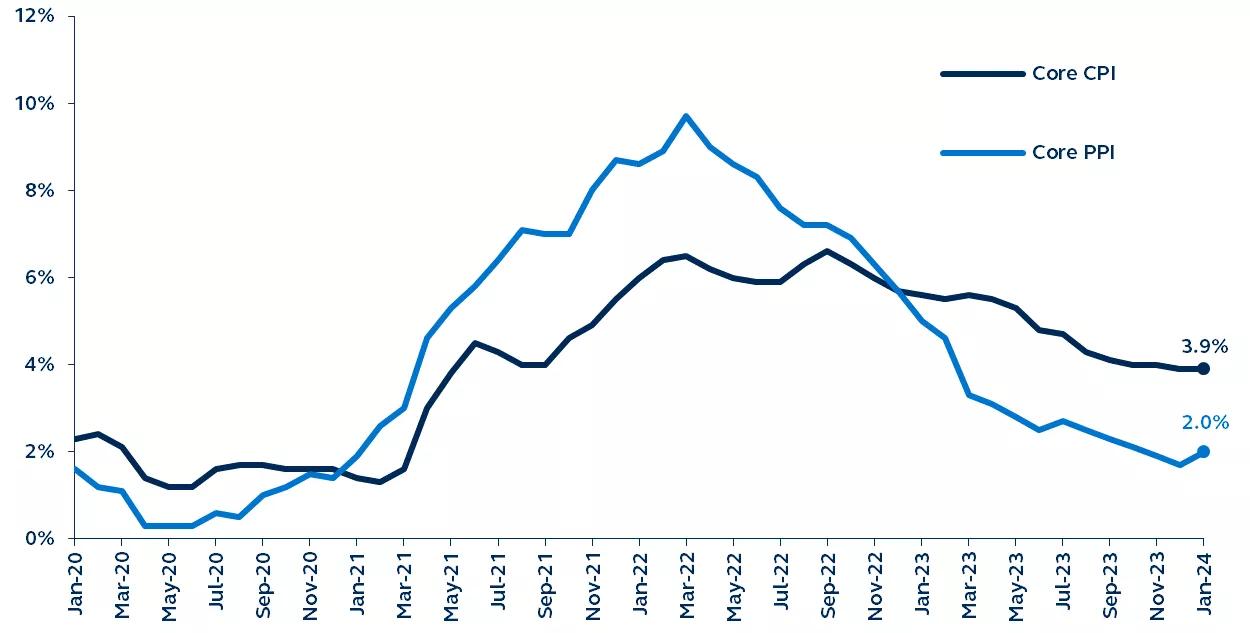The January Consumer Price Index (CPI) and Producer Price Index (PPI) inflation reports both came in hotter than expected—underscoring the challenge of reaching the Fed's 2% inflation target. Policymakers have repeatedly noted the need for additional evidence of sustained disinflation before they will cut rates. As a result, the market's expectations are beginning to fall in line, with their anticipation of numerous rate cuts adjusting to a more moderate expectation of three to four cuts starting around mid-year.

Core Consumer Price Index and Core Producer Price Index
January 2020–present

Since the start of 2024, markets have been gradually realizing that the goldilocks combination of an economic soft landing and aggressive Federal Reserve (Fed) policy rate cuts is unrealistic. The two inflation reports this week, the January Consumer Price Index (CPI) and Producer Price Index (PPI) reports, both drove home the point that inflation's last mile toward the Fed's 2% target will prove bumpy, frustrating, and tricky.
The latest U.S. CPI print showed that annual core inflation failed to decline, flatlining at 3.9% in January. The sticky inflation narrative was further reinforced by the stronger-than-expected January PPI print, which was fueled by a sizable jump in the cost of services—delivering a final heavy blow to the market's "smooth and easy" disinflation narrative. Certainly, the continued strength of economic data—as reflected across a number of activity indicators, particularly the January jobs report—implies that price pressures are unlikely to erode rapidly.
The Fed has emphasized the need for additional evidence of sustained disinflation before they can cut policy rates. Neither of this week's inflation reports have ticked that box. As such, a March cut and maybe even a May cut are off the table. Market pricing has now shifted away from expecting seven to eight rate cuts this year to a more realistic three to four cuts, starting around mid-year—finally in line with our own view.
Investing involves risk, including possible loss of principal. Past performance is no guarantee of future results and should not be relied upon to make an investment decision.
The information presented has been derived from sources believed to be accurate; however, we do not independently verify or guarantee its accuracy or validity. Any reference to a specific investment or security does not constitute a recommendation to buy, sell, or hold such investment or security, and does not take account of any investor’s investment objectives or financial situation and should not be construed as specific investment advice, a recommendation, or be relied on in any way as a guarantee, promise, forecast or prediction of future events regarding an investment or the markets in general. The opinions and predictions expressed are subject to change without prior notice.
Principal Funds, Inc. is distributed by Principal Funds Distributor, Inc.
Securities are offered through Principal Securities, Inc., 800-547-7754, Member SIPC and/or independent broker/dealers.
Principal Asset Management leads global asset management at Principal.®
For Public Distribution in the U.S. For Institutional, Professional, Qualified and/or Wholesale Investor Use only in other permitted jurisdictions as defined by local laws and regulations.
© 2024, Principal Financial Services, Inc. Principal Asset ManagementSM is a trade name of Principal Global Investors, LLC. Principal®, Principal Financial Group®, Principal Asset Management, and Principal and the logomark design are registered trademarks and service marks of Principal Financial Services, Inc., a Principal Financial Group company, in various countries around the world and may be used only with the permission of Principal Financial Services, Inc.
3397574


